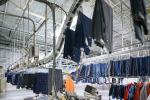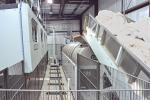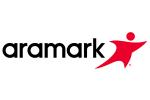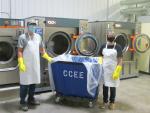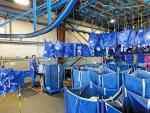SANTA MARIA, Calif. — The textile rental industry has seen significant change over the past several years as it recovers from the pandemic and attrition caused by employees voluntarily leaving their positions for various reasons.
This has caused the industry to revamp the way it does business by relying more on automation and simply doing more with fewer people.
While these situations are not mutually exclusive, they do require the industry to revisit how existing safety systems within the organizations must be improved to ensure fewer people doing the work are not exposed to additional risk.
SAFETY SYSTEM EVALUATION
Organizations must evaluate whether or not the safety systems that are in place are effective in this new environment. Does the organization have systems safety or is it safe by accident?
Does safety get the same attention as production, service and quality? Now that there are fewer employees, the organization must ensure that safety represents the fourth leg of the operational stool.
Success means producing quality hygienically clean textiles and serving customers who benefit from those textiles without exposing employees to undue risk.
If the organization is to be successful, it must adopt a form of system safety. Without a system, the safety of an organization is subject to myriad elements, not the least of which is luck.
System safety is a systematic and proactive approach to managing safety risks. Risk management activities are at the heart of system safety, including the identification of safety hazards, risk assessments, and risk mitigation and prevention.
The four pillars of system safety are to prepare, prevent, protect and respond.
AUTOMATION AND SAFETY
Once a system approach to safety is adopted, then implementing concepts such as automation can be considered.
Before automating any process in the laundry, a study should be conducted to identify risks or hazards the automation might present.
Shuttles, conveyors, presses and other components that operate automatically and without warning must be considered. How might the washroom operator who is now subjected to the automatic movement be injured?
Preparation is performing a thorough analysis of the operation and considering solutions to any risks prior to installation. Plans to prevent the operator from entering the area until he/she has disabled and locked out the automated equipment must be developed.
Using a process that prevents exposure to the operator protects both the operator and the organization.
Response would be identifying any weaknesses in the plan and addressing those weaknesses as they occur. These plans can’t be simply to place signage in the washroom warning of the hazard.
Textile rental industry operations over time have erred in over-reliance on signage.
Regulatory agencies require the use of signs; however, the signs, in themselves, provide little effectiveness in preventing risk. Signs simply become white noise that gets little attention after exposure to them over a period of time.
Signs are helpful but not the best way to convey safety messages.
Often, operators post signs warning employees of potential hazards and assume that their responsibility has been fulfilled.
The more effective means of warning employees of the hazards associated with their job is to provide training specifically identifying the hazards and the means to prevent injuries.
In addition, operators must expect employees to recognize and report hazards as they occur in the workplace.
MORE NEED FOR SAFETY TRAINING
Operators must ensure that employees receive proper training specific to the tasks to which they are assigned.
As the industry sees more operations where staff is reduced due to automation or attrition, it becomes more important that the training of individuals becomes more powerful.
It’s not enough to expose the individuals to the training topic. The training must ensure that the individuals understand and can demonstrate proficiency.
Proficiency means not only to operate the equipment but to operate it in a manner that protects the employee and coworkers from hazards.
Each training module should have a test or proficiency evaluation as the final step in the training. This step would help ensure that employees are actively participating in the training in order to demonstrate their understanding of the subject.
The inclusion of a proficiency element would prevent the need to retrain when an employee has failed to perform as expected.
Retraining due to a failure is evidence that the original training was not effective.
In a program that uses system safety, proper training is integral in preparation for, and prevention of, injuries, it is not foolproof.
It’s not enough to determine that training has been conducted. The organization must develop a means to measure its effectiveness.
Once the training has been completed and serves as an antecedent to the performance of the job, much the same as a sign serves as an antecedent, supervisors, leads and managers must observe the job being completed in order to ensure it is being performed properly.
Feedback, both positive and constructive, should be used to reinforce the proper performance of an activity. Without feedback, the employees assume that the job is being done properly even when it’s not.
BEYOND THE WASHROOM FLOOR
To further the discussion of observation and feedback, management should develop in their system a relationship with their employees that connects working safely with life outside of work.
Ensuring that employees know how a work-related injury has a negative impact on their lives is critical to getting the performance/behavior that is expected.
Things like the inability to do activities that an employee normally enjoys—attending kids’ games, attending sporting events, participating in sporting activities, handling day-to-day chores and providing for the family are all examples of the negative impact that an injury can create.
Additionally, life outside of work is impacted by visits to healthcare providers and physical therapy that consume hours in a day.
It’s not enough to “tell them” how to work safely. It is far more impactful to explain why working safely will benefit the employee and his/her family.
FINAL THOUGHTS
In conclusion, now that the industry is feeling the effects of a reduced workforce, it is in a position where it must pivot from the traditional approach of simply processing clean textiles and delivering them to customers while overlooking operational safety to ensuring that the safety of the depleted workforce is considered of equal importance.
Automation can assist in this area; however, as we saw, automation presents risks that require preparation, prevention, protection and response.
RELATED STORIES
Reinvigorating Laundry Facility Safety (Part 1), Feb. 21, 2023
Reinvigorating Laundry Facility Safety (Conclusion), Feb. 22, 2023
Have a question or comment? E-mail our editor Matt Poe at [email protected].



